Cultivating a School Culture for Climate Action - The Barcelona example
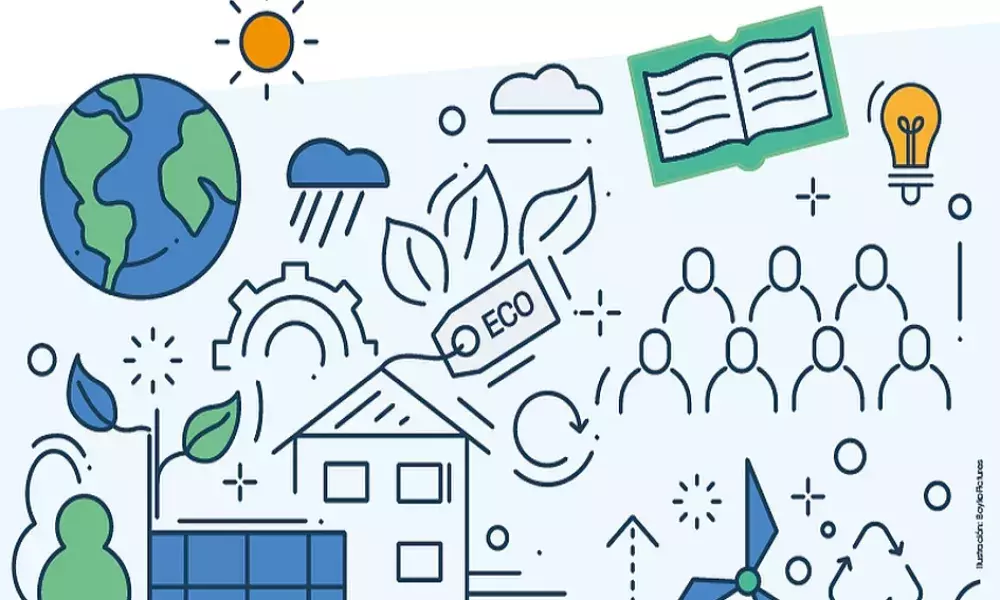
As a matter of fact, more and more schools around the world are adopting school approaches to climate action. The main idea of such approaches is that all members of the school community - the educational personnel, the students, the families, the scientific community and the local society - need to be involved in order to address diverse education and climate issues. Furthermore, attention is given to the open schooling concept, namely that schools, in cooperation with local communities and stakeholders, become agents of community well-being.
The Climate Shelters project
Current environmental problems such as climate change, air pollution, thermal heat, excessive waste production, etc. culminate where most people live: in cities. To this end, cities are transforming into laboratories for building climate resilience as well as for managing, promoting and sustaining change. On the other hand, the gap between the need for participation and the actual activation appears to be especially large in cities.
The Climate Shelters Project aims at the adaptation of Barcelona to climate change as far as the thermal environment is concerned. In the course of the project, eleven (11) schools in all districts of Barcelona were converted to Climate Shelters, i.e. areas where urban heat is reduced through green, blue and grey interventions (see Image below). The project coordinated by the City Council of Barcelona, is supported by the Urban Innovative Actions of the European Commission and runs for the period 2019 2022 (for a description of the technical interventions regarding the conversion of schools to Climate Shelters, have a look here).
Current environmental problems such as climate change, air pollution, thermal heat, excessive waste production, etc. culminate where most people live: in cities. To this end, cities are transforming into laboratories for building climate resilience as well as for managing, promoting and sustaining change. On the other hand, the gap between the need for participation and the actual activation appears to be especially large in cities.
The Climate Shelters Project aims at the adaptation of Barcelona to climate change as far as the thermal environment is concerned. In the course of the project, eleven (11) schools in all districts of Barcelona were converted to Climate Shelters, i.e. areas where urban heat is reduced through green, blue and grey interventions (see Image below). The project coordinated by the City Council of Barcelona, is supported by the Urban Innovative Actions of the European Commission and runs for the period 2019 2022 (for a description of the technical interventions regarding the conversion of schools to Climate Shelters, have a look here).
Furthermore, the project promotes the perspective of the cities as urban ecosystems and is directly linked to the Green Deal of the European Union as well as to a number of recent EU strategies for: (a) Nature Based Solutions (NBS) (b) Climate Neutral Cities by the year 2050 and (c) Climate Friendly Cities and (d) Smart cities.
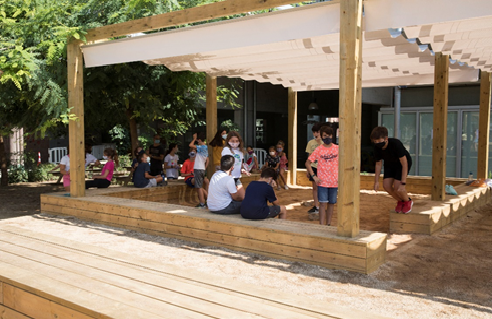
Furthermore, the project promotes the perspective of the cities as urban ecosystems and is directly linked to the Green Deal of the European Union as well as to a number of recent EU strategies for: (a) Nature Based Solutions (NBS) (b) Climate Neutral Cities by the year 2050 and (c) Climate Friendly Cities and (d) Smart cities.

However, it should be mentioned that the project does not simply refer to the needed technical interventions in the schools (including their buildings and yards). Nor it is exhausted in simply measuring air temperature at a daily basis, in order to recognize whether an amelioration to heat has been achieved.
On the contrary, the project emphasizes also on its pedagogical dimension, practically its capacity to motivate the educational society (students and teachers) to climate change issues and cultivate a new understanding on the role of schools as agents of well-being.
More importantly, it develops a collective spirit for actions which is not exhausted in the school environment, but rather encompasses the local society (mostly at the neighborhood scale) and stakeholders.
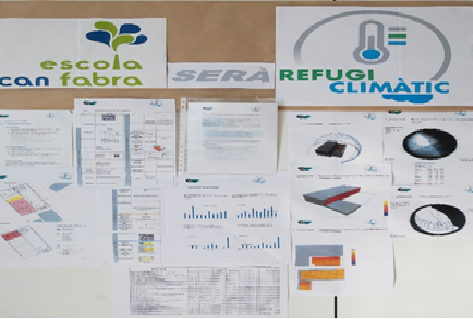
However, it should be mentioned that the project does not simply refer to the needed technical interventions in the schools (including their buildings and yards). Nor it is exhausted in simply measuring air temperature at a daily basis, in order to recognize whether an amelioration to heat has been achieved.
On the contrary, the project emphasizes also on its pedagogical dimension, practically its capacity to motivate the educational society (students and teachers) to climate change issues and cultivate a new understanding on the role of schools as agents of well-being.
More importantly, it develops a collective spirit for actions which is not exhausted in the school environment, but rather encompasses the local society (mostly at the neighborhood scale) and stakeholders.

The educational aims of the Climate Shelters project
(a) the development of a learning, exploring and activation network which allows to experience and understand the pressures to an urban area from climate change and the ways to act, so as to overcome challenges,
(b) the establishment of concepts to recognize the strong links of the natural environment, the built environment and the socio-economic environment. Understanding these links is essential to identify the capacity to participate in shaping the own living environment,
(c) the shaping of knowledgeable, innovative and participatory communities able to cope with and actively contribute to addressing current and anticipated climate challenges at the city scale.
A novel process for learning
While schools provide a particularly effective starting point to teach students about cause and effect relationships, putting knowledge into actions requires the engagement of the communities at large including parents, families, neighborhoods, universities, local authorities, etc. Thus the process of learning should be augmented by opportunities to explore, test and even implement some of these concepts in real life situations (see the flow chart below as related to the Climate Shelters project). As a matter of fact this is exactly the approach promoted by the network of Sustainable Schools in Barcelona (see here for additional information)
The Climate Shelters project practically applies the open schooling concept, as discussed above. Real life projects, namely the conversion of the schools to Climate Shelters by means of a mix of climate adaptation interventions, were promoted, but only once they were at first discussed in the school society.
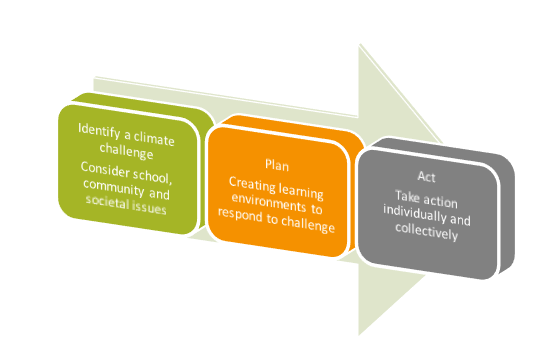
The educational aims of the Climate Shelters project
(a) the development of a learning, exploring and activation network which allows to experience and understand the pressures to an urban area from climate change and the ways to act, so as to overcome challenges,
(b) the establishment of concepts to recognize the strong links of the natural environment, the built environment and the socio-economic environment. Understanding these links is essential to identify the capacity to participate in shaping the own living environment,
(c) the shaping of knowledgeable, innovative and participatory communities able to cope with and actively contribute to addressing current and anticipated climate challenges at the city scale.
A novel process for learning
While schools provide a particularly effective starting point to teach students about cause and effect relationships, putting knowledge into actions requires the engagement of the communities at large including parents, families, neighborhoods, universities, local authorities, etc. Thus the process of learning should be augmented by opportunities to explore, test and even implement some of these concepts in real life situations (see the flow chart below as related to the Climate Shelters project). As a matter of fact this is exactly the approach promoted by the network of Sustainable Schools in Barcelona (see here for additional information)
The Climate Shelters project practically applies the open schooling concept, as discussed above. Real life projects, namely the conversion of the schools to Climate Shelters by means of a mix of climate adaptation interventions, were promoted, but only once they were at first discussed in the school society.

Families were also encouraged to become real partners in school life and activities, whereas the interaction with the technical (architects) and science teams of the project facilitated an open environment for the exchange of views and for constructive deliberations (see the Figure which follows) .
This is not usually the case in school projects. Saying this it was considered important to assess the project from the perspective of the teachers and the students.
For doing so a set of questions (Annex I) specially developed for the Climate Shelters project in such categories as school governance, teaching and learning, campus life, community associations and school collaborations (Unesco, A teacher's guide to taking actions, 2017), were addressed to a representative sample of schools in the Climate Shelters Network. A selection of their answers is provided below.

Families were also encouraged to become real partners in school life and activities, whereas the interaction with the technical (architects) and science teams of the project facilitated an open environment for the exchange of views and for constructive deliberations (see the Figure which follows) .
This is not usually the case in school projects. Saying this it was considered important to assess the project from the perspective of the teachers and the students.
For doing so a set of questions (Annex I) specially developed for the Climate Shelters project in such categories as school governance, teaching and learning, campus life, community associations and school collaborations (Unesco, A teacher's guide to taking actions, 2017), were addressed to a representative sample of schools in the Climate Shelters Network. A selection of their answers is provided below.

School governance
A question of considerable interest is whether the project modified the school governance processes and patterns. The question “Whether the project supported the participation of teachers, students and families in active deliberations and decision making on climate action in schools΅ was placed to schools in the project.
According to Nuria Martin De Sol, Head of studies at the Poblenou school:
We have created a sustainability committee to work on all these actions that may affect the school. We also hold joint meetings to agree on actions
Taken the theme of the Climate Shelters project, schools were also asked on the contribution of the project towards the development of school culture on climate change and related actions. The answer from Poblenou school was:
Now we are part of the "MORE Sustainable schools" NETWORK…Also this year the theme of the cultural days has to do with climate change, sustainability and recycling among others
On another question, namely whether the project helped teachers and students to contribute to the improvement of their own schools, all answers from the schools were positive, a fact which demonstrates the collective spirit developed for the conversion of the schools to Climate Shelters.

School governance
A question of considerable interest is whether the project modified the school governance processes and patterns. The question “Whether the project supported the participation of teachers, students and families in active deliberations and decision making on climate action in schools΅ was placed to schools in the project.
According to Nuria Martin De Sol, Head of studies at the Poblenou school:
We have created a sustainability committee to work on all these actions that may affect the school. We also hold joint meetings to agree on actions
Taken the theme of the Climate Shelters project, schools were also asked on the contribution of the project towards the development of school culture on climate change and related actions. The answer from Poblenou school was:
Now we are part of the "MORE Sustainable schools" NETWORK…Also this year the theme of the cultural days has to do with climate change, sustainability and recycling among others
On another question, namely whether the project helped teachers and students to contribute to the improvement of their own schools, all answers from the schools were positive, a fact which demonstrates the collective spirit developed for the conversion of the schools to Climate Shelters.

Teaching and learning
An interesting aspect for investigation was whether the project empowered the students to take action on issues related to real-life climate change.
As Pia Ivanco and Maria Elizondo, school teachers from Can Fabra school, said:
Perhaps it has been the most gratifying part of the whole participatory process. Namely that the voice of the students was heard and that their demands were materialized with real interventions in their schools
Their colleagues Marta Riba (Head of Studies), Iolanda Abad and Maria Marques (Director) from Villa Olimpica school also agree:
Everything was working out with the students, through conversation and debates on the subject under consideration
It is by no surprise that Laia and Eric, students at 6th grade at Can Fabra school noted that:
They asked for our opinion and they respected it
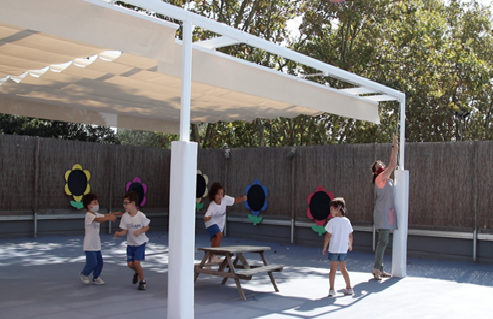
Teaching and learning
An interesting aspect for investigation was whether the project empowered the students to take action on issues related to real-life climate change.
As Pia Ivanco and Maria Elizondo, school teachers from Can Fabra school, said:
Perhaps it has been the most gratifying part of the whole participatory process. Namely that the voice of the students was heard and that their demands were materialized with real interventions in their schools
Their colleagues Marta Riba (Head of Studies), Iolanda Abad and Maria Marques (Director) from Villa Olimpica school also agree:
Everything was working out with the students, through conversation and debates on the subject under consideration
It is by no surprise that Laia and Eric, students at 6th grade at Can Fabra school noted that:
They asked for our opinion and they respected it

On another question, it was examined whether the schools had the chance to discuss the project with the educational community at large and to explain the importance of the project for climate change adaptation.
In her answer Lluisa Lopez, Director and Head of Studies of Font d'en Fargas School was positive, where Núria Martin del Sol from Poblenou school stated that:
We have extended the content of the project to the whole educational community and we have also explained it to the families in the beginning of the school year
The school Campus as a teaching tool for a climate friendly school society
When schools were asked whether the school campus was used as a teaching tool to develop knowledge, skills and values for a climate friendly school society, a positive climate was recognized.
The Can Fabra school noted:
I don΄t know if it is like this or vice versa. What is clear is that there is a profound change in society and schools are a good place to start. It is a perfect framework from which to plant the seed of love and respect for those around us as well as to grow a critical vision to act in the climatic emergency to which we find ourselves

On another question, it was examined whether the schools had the chance to discuss the project with the educational community at large and to explain the importance of the project for climate change adaptation.
In her answer Lluisa Lopez, Director and Head of Studies of Font d'en Fargas School was positive, where Núria Martin del Sol from Poblenou school stated that:
We have extended the content of the project to the whole educational community and we have also explained it to the families in the beginning of the school year
The school Campus as a teaching tool for a climate friendly school society
When schools were asked whether the school campus was used as a teaching tool to develop knowledge, skills and values for a climate friendly school society, a positive climate was recognized.
The Can Fabra school noted:
I don΄t know if it is like this or vice versa. What is clear is that there is a profound change in society and schools are a good place to start. It is a perfect framework from which to plant the seed of love and respect for those around us as well as to grow a critical vision to act in the climatic emergency to which we find ourselves

The statement from Can Fabra school is not the exception, but rather the rule as the Font d' en Fargas and the Poblenou schools also agreed, whereas the answer of the Villa Olimpica School reads as:
The project helps to raise awareness throughout the community and fosters attitudes of respect and responsibility
Community Associations
We think that our climate action project responds to the need for the neighborhood to protect against the progressive rise in temperature and that it helps to spread the culture of climate and sustainability among a population that may not be sufficiently aware of the issue
This excellent quote comes from the educators of Poblenou school and is strengthened by the respective statement from the educators of Can Fabra school. After all, the Climate Shelters will be also open for use by the local residents and the public at large, once an extreme heat event takes place.
School collaborations
In a question mostly relating to the replication potential of the Climate Shelters Project to other schooLs in Barcelona or other cities, the educators from Can Fabra school mention:
It would be very interesting to able to help a school that has the same interest with our school. One of the things we valued most about the whole process was the support of experts for our concerns and any uncertainties that arose
Some concluding points - Climate education for and with the schools
A clear conclusion from the analysis of the questionnaires, is that students and the educational staff at the Climate Shelters schools show a greater sense of belonging in the school community and take part in meaningful, relevant, and hands-on learning opportunities regarding adaptation to climate change and iits impacts.
In general terms, the Climate Shelters project provides, in collaboration with local governments and communities, teaching and learning in the field of “cities and climate change” with these characteristics:
- Experiental – Engage the participants in a “learning by doing” environment through direct and collaborative involvement in community driven projects.
- Multidisciplinary – Involve expertise in several fields of research in an integrated environment.
- Experimental – A design/research approach links creative tools with scientific measurements and monitoring.
- Innovative – Provide ground-breaking methodologies and approaches.
- Community engaging – Builds a strong link between local communities, engaging key stakeholders and enhancing social commitment of the students through exchanges with the urban actors.
The statement from Can Fabra school is not the exception, but rather the rule as the Font d' en Fargas and the Poblenou schools also agreed, whereas the answer of the Villa Olimpica School reads as:
The project helps to raise awareness throughout the community and fosters attitudes of respect and responsibility
Community Associations
We think that our climate action project responds to the need for the neighborhood to protect against the progressive rise in temperature and that it helps to spread the culture of climate and sustainability among a population that may not be sufficiently aware of the issue
This excellent quote comes from the educators of Poblenou school and is strengthened by the respective statement from the educators of Can Fabra school. After all, the Climate Shelters will be also open for use by the local residents and the public at large, once an extreme heat event takes place.
School collaborations
In a question mostly relating to the replication potential of the Climate Shelters Project to other schooLs in Barcelona or other cities, the educators from Can Fabra school mention:
It would be very interesting to able to help a school that has the same interest with our school. One of the things we valued most about the whole process was the support of experts for our concerns and any uncertainties that arose
Some concluding points - Climate education for and with the schools
A clear conclusion from the analysis of the questionnaires, is that students and the educational staff at the Climate Shelters schools show a greater sense of belonging in the school community and take part in meaningful, relevant, and hands-on learning opportunities regarding adaptation to climate change and iits impacts.
In general terms, the Climate Shelters project provides, in collaboration with local governments and communities, teaching and learning in the field of “cities and climate change” with these characteristics:
- Experiental – Engage the participants in a “learning by doing” environment through direct and collaborative involvement in community driven projects.
- Multidisciplinary – Involve expertise in several fields of research in an integrated environment.
- Experimental – A design/research approach links creative tools with scientific measurements and monitoring.
- Innovative – Provide ground-breaking methodologies and approaches.
- Community engaging – Builds a strong link between local communities, engaging key stakeholders and enhancing social commitment of the students through exchanges with the urban actors.
|
School Governance |
|
1. Did the project help the school to develop a school culture on climate action? |
|
2. Did the project support the involvement of teachers, students and parents in active deliberations and decision making for climate action at the school level? |
|
3. Did the project help teachers and students feel that they contributed to the improvement of their own school? |
|
Teaching and Learning |
|
4. Did the project support teaching of the subject of climate change to the students? |
|
5. Were you able to discuss the project with the local community and explain its importance for climate change adaptation? |
|
6. Did the project empower your students to take action on real-life climate change issues? |
|
7. Did the students comprehend the link of the technical interventions, as implemented at the school, to climate change adaptation? |
|
Campus Life |
|
9. Did the project help to make your school campus a model of collaborative work towards a common goal? |
|
10. Did the project use your school campus as a teaching tool for developing the knowledge, skills, and values needed to create a more climate friendly school society? |
|
Community Partnerships |
|
11. Did the project help to build partnerships with parents, local organizations and businesses? |
|
12. Did the project led to parents volunteering in school climate action? |
|
13. Did the project help to align your school's climate action projects with the needs of your local community? |
|
14. Did the project improve the willingness of students to become agents of information dissemination at the neighborhood scale, about climate change? |
|
School Partnerships |
|
15. Would your school be interested to support another school in Barcelona or in another city in Spain or abroad to implement a similar project? |
|
16. Did the project motivate your school to participate to a city, national or international network on climate action? |
About this resource
The Urban Innovative Actions (UIA) is a European Union initiative that provided funding to urban areas across Europe to test new and unproven solutions to urban challenges. The initiative had a total ERDF budget of €372 million for 2014-2020.
Similar content




